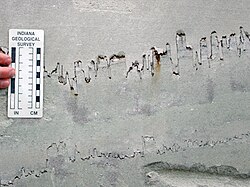Stylolite

Stylolites (Greek: stylos, pillar; lithos, stone) are serrated surfaces within a
Classification of stylolites
In structural geology and diagenesis, pressure solution or pressure dissolution is a deformation mechanism that involves the dissolution of minerals at grain-to-grain contacts into an aqueous pore fluid in areas of relatively high stress and either deposition in regions of relatively low stress within the same rock or their complete removal from the rock within the fluid. It is an example of diffusive mass transfer. Stylolites are formed by this process.
Stylolites can be classified according to their geometry or their orientation and relationship to bedding.[4]
Geometric classification
Park and Schot (1968) recognized six different geometries in stylolites:[4]
- Simple or primitive wave-like
- Sutured type
- Up-peak type (rectangular type)
- Down-peak type (rectangular type)
- Sharp-peak type (tapered and pointed)
- Seismogram type
Relationship to bedding
- Horizontal stylolites
- This is the most commonly observed stylolite type. They occur parallel or nearly parallel to the bedding of rocks. This type is most frequently found in layered sedimentary rocks, mostly in carbonate rocks, which have not been affected by intensive tectonic structural activity or metamorphism.
- Inclined stylolites or slickolites
- This type occurs oblique to bedding. It appears in rocks which are both affected or unaffected by tectonic activity, and can also be found in metamorphic and layered igneous rocks.
- Horizontal-inclined (vertical) or crosscutting stylolites
- This type is a combination of horizontal and inclined types of stylolites. Horizontal stylolites usually have a higher amplitude than inclined stylolites. Horizontal-inclined can be found in rocks affected by pressure parallel to the bedding plane followed by pressure perpendicular to bedding.
- Vertical stylolites
- This type of stylolite is related to the bedding at right angles. It may or may not be associated with tectonic activity. It is caused by pressure acting perpendicularly to the bedding.
- Interconnecting network stylolites
- This type is a network of stylolites, which are related to each other with relatively small angles. This type can be divided into two subtypes. Stylolites of subtype A are characterized by higher amplitudes. They are related to the bedding either horizontally, or at a small angle. Stylolites of subtype B usually appear in rocks which have been affected by tectonic and/or metamorphic activity. These stylolites have a low amplitude with undulations. Their relation to the bedding can vary from horizontal to vertical.
- Vertical-inclined (horizontal) or crosscutting stylolites
- This type is a combination of horizontal or inclined and vertical stylolite types. In this case the inclined or horizontal stylolites were formed first and the vertical later. This type can be divided into two subtypes by directions of displacement of the inclined stylolites. In subtype A, the displacements could have happened during vertical stylolization, while in subtype B, the displacements could have happened before vertical stylolization.
Development
A stylolite is not a
In order for a stylolite to develop, a
Significance
Stylolites are significant in several fields. In
Gallery
-
A stylolite viewed in thin section in plane polarized light in a packstone, Oehrlikalk formation of the Axen nappe, Wellenberg, Switzerland
-
Stylolite in a Slovakian limestone
See also
- Fold (geology)
- Rock microstructure
References
- ^ Dunham J.B.; Larter S. (1981). "Association of Stylolitic Carbonates and Organic Matter: Implications for Temperature Control on Stylolite Formation". AAPG Bulletin. 65.
- ^ a b c Middleton, Gerard V., Encyclopedia of sediments and sedimentary rocks, 2003, p. 90-92
- .
- ^ .
- S2CID 128917505.
- ^ Petrology of the sedimentary rocks, F.H. Hatch, R.H. Rastall p. 382
- ^ Fletcher, C.C. and Pollard, D.D. 1981 Anticrack model for pressure solution surfaces. Geology, 9, 419-24.
- ^ Rye, DM, and Bradbury, HJ (1988): Fluid flow in the crust: an example from a Pyrenean thrust ramp. American Journal of Science (288): 197-235.
- ^ Merino, E., Ortoleva, P., and Strickholm, P., 1983. Generation of evenly-spaced pressure-solution seams during (late) diagenesis: a kinetic theory. Contributions to Mineralogy and Petrology, 82: 360-370.


